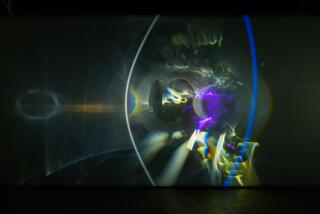Art Review : Exploring the Allure of the Anomaly
- Share via
The allure of the ideal is matched by the allure of the misshapen: deformed lemons with ulcerated skins; tortured bits of volcanic debris in which one can see romantic landscapes; hydrocephalic children with flowerlike heads; bottled organs preserved on dust-caked shelves; and aberrant skeletons that may not be for real.
At the Getty Center for the History of Art and the Humanities, guest curator Rosamond Purcell gathers illustrations of such anomalies from books, manuscripts, catalogues and prints in the Getty collection--mixing up literary conceits, historical wonders, biological errors and sideshow phenomena with the indiscriminate zeal of one obsessed.
These illustrations are displayed along with a cabinet of curiosities on loan from Purcell’s own collection; and color photographs Purcell has taken in the back rooms of anatomical museums and medical schools. Her curatorial endeavor recalls a range of contemporary work, from Zoe Leonard’s recent images of wax models in natural history museums to Joel-Peter Witkin’s photographs of tarted-up grotesques. Yet whereas these artists indulge our baser instincts in order to make us question our own voyeurism, Purcell stops short at indulgence.
On that level, the exhibition is marvelous. Filled with things like Queen Victoria’s stocking, a five-headed lizard and a voluptuous bunny toy, it is quite like a Dali painting come to life--the uncanny represented with manic exactitude. Yet, on the whole, the show feels like a series of missed opportunities. Among them, the opportunity to analyze how all art objects are, by definition, anomalies, and to acknowledge the cultural specificity of “normalcy,” in opposition to which these “freakish” artifacts acquire their morbid charm.
* The Getty Center for the History of Art and the Humanities, 401 Wilshire Blvd., Santa Monica, (310) 458-9811, through Dec. 17. Closed Sunday.
More to Read
The biggest entertainment stories
Get our big stories about Hollywood, film, television, music, arts, culture and more right in your inbox as soon as they publish.
You may occasionally receive promotional content from the Los Angeles Times.










